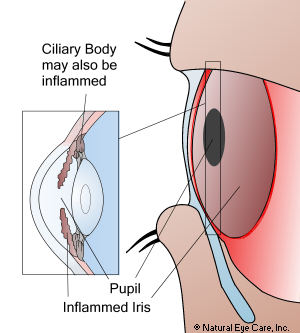Uvea

The uvea consists of three structures:
- The iris is the circular pigmented membrane, surrounding the pupil of the eye that provides the eye with its color. The iris controls the size of the pupil in reaction to the brightness of light exposure. Inflammation of the iris is called iritis or anterior uveitis.
- The ciliary body is a structure containing muscle and is located behind the iris which focuses the lens. Inflammation of the ciliary body is called cyclitis or intermediate uveitis.
- The choroid is a layer containing blood vessels that line the back of the eye and is located between the inner visually sensitive layer, called the retina, and the outer white eye wall, called the sclera. Inflammation of the choroid is known as choroiditis or posterior uveitis.
 info@naturaleyecare.com
info@naturaleyecare.com



 Home
Home



 Vision
Vision Vision
Vision



 Health
Health Health
Health Research/Services
Research/Services Pets
Pets About/Contact
About/Contact


